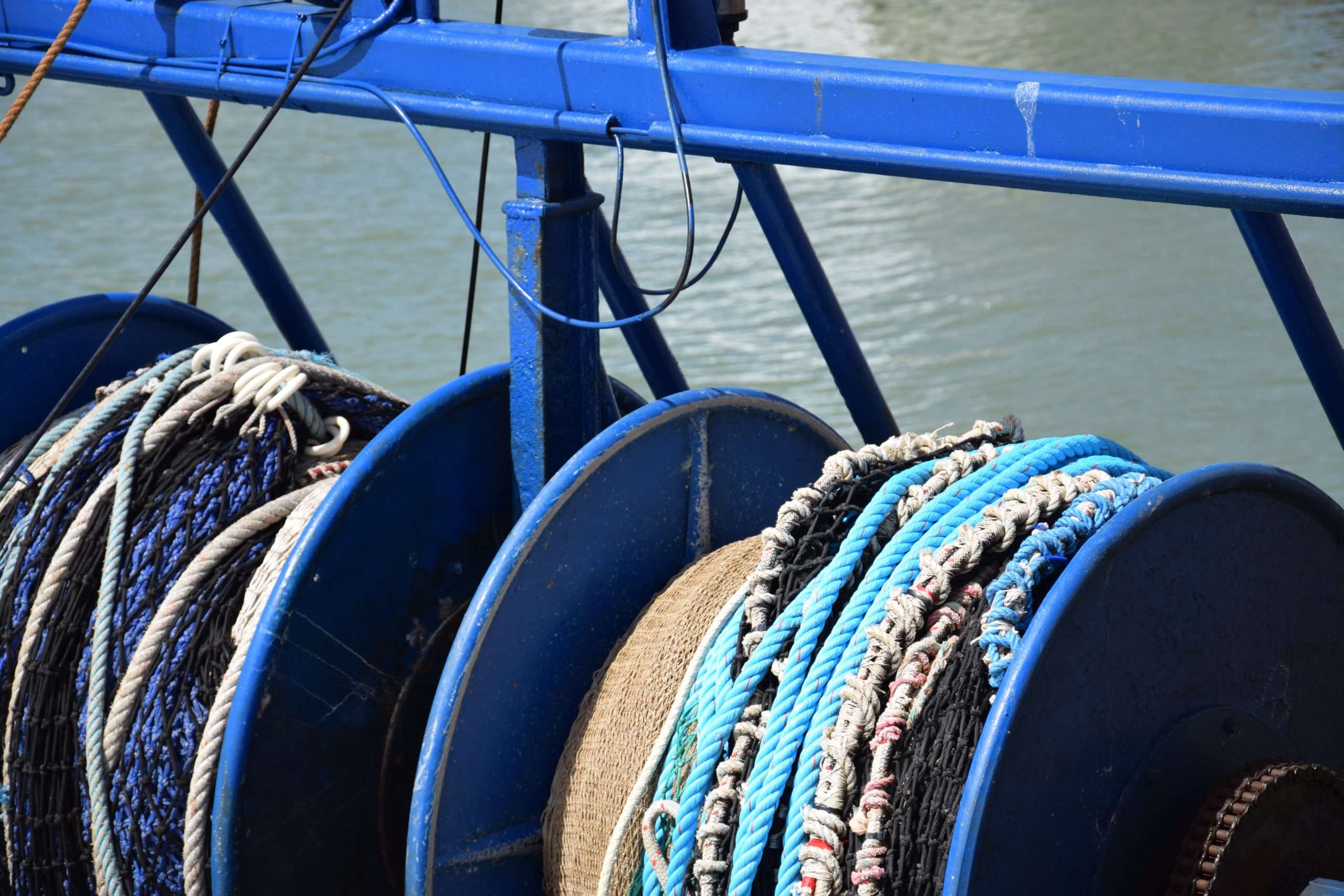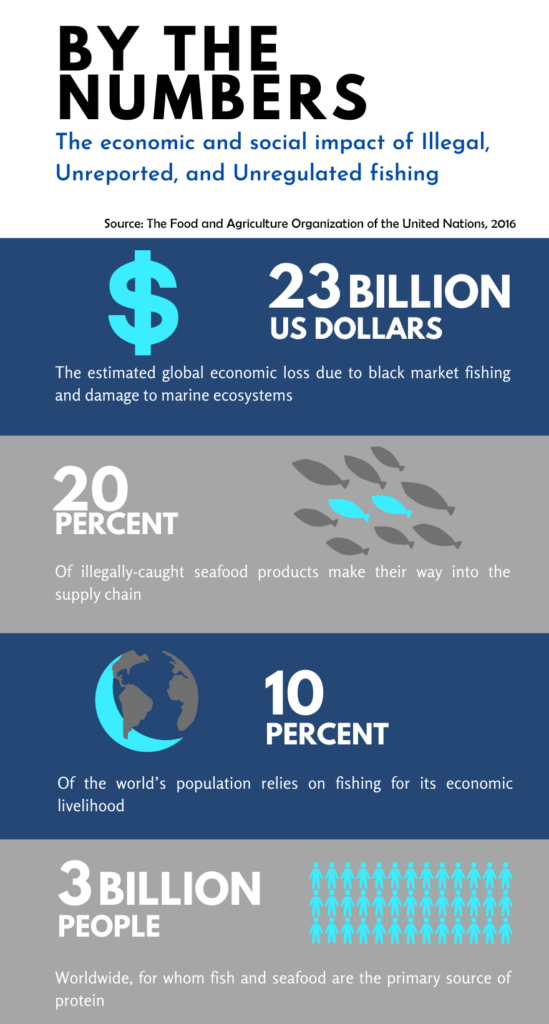Our oceans are bountiful, but not infinite.
Global fish populations–a critical food and income source for more than 10% of the world’s population–are facing collapse. The U.N. Food and Agriculture Organization (FAO), estimates that Illegal, Unreported, and Unregulated (IUU) fishing accounts for around 20% of the annual catch in the world’s oceans. The number might not resonate, but the devastating results of IUU fishing are widespread and long-lasting, jeopardizing vulnerable marine populations and ecosystems, food security, and even national stability.
- Overfishing depletes once-robust fish stocks and counteracts sustainable management efforts.
- Trawling destroys fragile aquaculture habitats and conservation areas.
- Developing countries that rely on legal fishing operations can’t reach viable numbers.
- Criminal activity violates marine resource laws and human rights protections.
- International maritime security is at risk, as IUU fishing boats target areas that cross borders or are at the far reaches of the EEZ.
IUU Fishing is an International Concern
Organizations as far reaching as the United Nations and the World Wildlife Fund have identified IUU fishing as a critical threat to economic stability and the global supply chain, with significant environmental impacts, and links to transborder organized crime and human rights violations. International agreements are designed to support healthy oceans, but efforts toward global sustainability are impeded by illegal activities in the fishing sector.
Answering to no authorities, these black-market fisheries have few qualms about operating in restricted, sensitive areas, littering the seas with abandoned equipment, or employing destructive commercial operations that wreak havoc on the underwater ecosystems, sea beds, and marine life. Further, the threat to fish populations affects not only global supply, but also severely impacts the livelihoods of more than 700 million people who rely on fishing as their main source of income. Often, these are small, family businesses, who, when their nets come up empty, are directly affected. Sometimes, IUU fishing is hiding something much worse. Alone and hard to detect on the high seas, fishing vessels are often used in nefarious activities including fraud and tax evasion, and more egregious crimes like drug, arms, or human trafficking and slavery.
Something’s Fishy…
Unfortunately, the black market for seafood is thriving, and its operators are getting ever savvier. Governments and economic stakeholders are finding it increasingly difficult to prevent or thwart these extremely detrimental activities. Illegal fisheries continue to exist because they can quickly adapt to any new regulations or government controls, keeping one step ahead of traditional maritime surveillance procedures.
Flying false flags (or none at all)? No reported catch? Trawling in protected areas?
Illegal fishing is a form of piracy.
It goes without saying that an industry that operates outside of national or international laws is unlikely to participate in voluntary reporting. As is the case for all pirates, the self-reported AIS location or tracking data will be unreliable for shady fishing vessels. Single boats in the vast Exclusive Economic Zone (EEZ), operating under dark of night or many hours from shore, know that they are minnows in a sea of maritime threats. Manned patrols are costly and hindered by distance. Satellite AIS (S-AIS) can have time lags. Microwave radar systems have a range of only 20-40 nm. The limitations of each of these systems on their own leave few options for effective monitoring of suspicious vessels.
So, what can be done?
Tightening the Net
The U.N.’s FAO and International Maritime Organization (IMO) agencies have introduced several measures and guidelines to help coastal nations counteract illegal fishing activity and support marine conservation, such as global records standards and unique vessel identification numbers. Catch documentation, vessel registration, Monitoring, Control, and Surveillance (MCS), and fisheries management all fall under the jurisdiction of flag states, which can enforce penalties upon violators. These steps work well to keep tabs on responsible fisheries who play by the rules, but how can countries trace non-compliant boats?
It all comes down to a unified Maritime Domain Awareness (MDA) system. Keeping the world’s ocean resources secure and healthy requires information from multiple sources and tools, including radar, satellite, existing records, and human observation.
For nations reliant on sustainable fishing operations, advanced data collection and persistent radar surveillance of the entire EEZ are essential. Maerospace’s trademarked PASE™ system uses High Frequency Surface Wave Radar (HFSWR) to monitor offshore activities from 20 nm to 220 nm in real time. Their TimeCaster™ predictive analytics software collates time-synchronized AIS and S-AIS data to accurately identify and track legitimate fishing vessels, and to highlight unidentified or dark boats and doppelganger signals. By eliminating the known entities, governments and commercial stakeholders can readily detect anomalies–and catch illegal activity as it happens.
Because the world’s oceans connect us all, IUU fishing is a dire threat to everyone. Coastal nations see the detriments firsthand in their waters and their ports, but end consumers suffer as well. We all need and deserve a robust, renewable ocean system, a stable resource supply chain, and safe seas. With advanced maritime intelligence, responsible agencies can now take control of this crisis in the most efficient, comprehensive manner. The time to act is now, and the tools to succeed are here.
About Maerospace
Transforming the awareness, assessment, and response to critical economic, environmental, and human threats in national maritime domains

